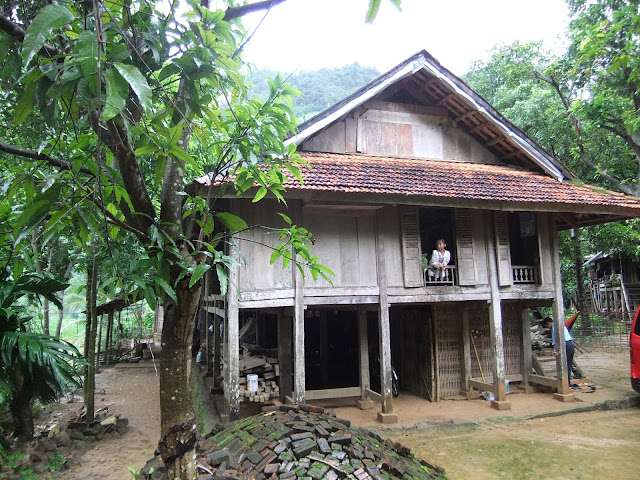One of the most unique things to do in Vietnam is to sign up to stay in a traditional Home Stay. You can go through a company like Vietnam Backpacker’s Hostel or you can try arrange it yourself.
For my Mai Chau homestay (photo above) I organised it through a tour agency on the street in Hanoi, but for my Sapa homestay (first photo, with young children) I simply met a Hmong family when I got off the bus and they agree to take me to their village the next day. The experience is unlike anything else you will have backpacking around Southeast Asia. Seeing how the locals live, eating the food that they cook and just appreciating the beauty of the landscape with no interruptions was by far one of the highlights of my entire trip to Vietnam.

Top tip: Bring some warm clothes and extra socks, it can get quite cold at night time, especially is Sapa.
Mai Chau Homestay
The traditional house of Thai People in Mai Chau is the house on stilts. This type of house is used for tourists for their overnight stay in Mai Chau and called Mai Chau Homestay (or communal dorm as tourist won’t have their own rooms but sharing the floor with others. Each individual/couple will be provided with mattress, blanket, pillow and mosquito net.

With this kind of accommodation, tourists don’t have private rooms or toilet in the room. They will use public toilets outside the homestay. It’s clean enough for tourists in western style.
Ban Lac Village Homestay
Coming to Lac Village, you will see stilt houses border both sides of the roads. The houses are quite large with palm leaf roofs and polished bamboo-slat floors. The kitchen is located in the center of the house; the cooking as well as the making of the colorful tho cam,
the material used by Thai minority to make their clothes, takes place in the kitchen. The windows are large and decorated with patterns. Each house also has a pond to breed fish. The Sunday market brings a lot of people into town. People from different minorities living in the mountains come to Mai Chau market to sell their specific products: honey, bananas, corn, and tho cam made by skilled Thai women. The Sunday market is also an occasion to enjoy traditional Thai dishes and to participate in traditional dances.
Pom Coong Village Homestay
Like other villages of the Muong and Thai ethnic minority groups, Pom Coong is often located in hilly areas where there are both rivers and streams. Houses are built against the mountains in front of the vast field but Thai’s floor is always taller to keep clean and airy. Most houses are built on stilts, 1.5m above the ground, having bamboo floors and roofs made from Goi or May leaves.

The most prominent thing is “pure Thai”, everything is very clean. Clean water and sanitation are regulated to give visitors to feel fresh and safe. Waste is classified, in containers and will be processed. Tourists will feel the freshness of earth and sky, and a peaceful life. Newcomers also have chance to be overwhelmed with the beautiful landscape of the ever-stretching rice fields in Mai Chau Valley.
Homestay and interaction with local lifestyle has become more popular for tourists and solo travelers. Meeting local girls charming and shy in their dance, talking to school kids, trying to do some Thai cooking, and all sort of other things tourists can do in Pom Coong will bring joy and relaxation.
Travellers will forget hard-working days, worries and are mingled in the life of the Thai people and enjoy traditional dances, the gong festivals, drinking wine, ect. Overnight stays in homes floating on the lake are also available in which tourists can participate in a gorgeous sunrise and enjoy the clean and pure atmosphere of the early morning.
Homestay tourism is becoming more and more attractive and familiar with tourists. It is the moment that visitors will remember Coong Pom village as well as the Thai people in Mai Chau.
Evisa Vietnam
50 USD(no stamp fee)
Apply evisa
Popular Posts
-
India is becoming a more popular travel destination for Indians. With its stunning landscape, rich history, and vibrant culture, Vietnam off...
-
Vietnam electronic visa (Vietnam E-visa) is one of visa types issued to foreigners by Vietnam Immigration Department via electronic system. ...
-
Overview of electronic visas Holders of Indian nationality are eligible to receive e-Visa in Vietnam. Electronic visa is a visa granted by...
-
Getting well acquainted with the immigration laws of one country before travelling is very important. Vietnam is also not an exception for ...
-
If you are looking for Vietnam tourist visa for your arrival by air, there’s nothing better than visa on arrival, which is both convenien...
-
Entry into Vietnam The requirements for Vietnam differ depending on your Nationality, length of stay and purpose of visit. If you are a ci...
-
Sapa Vietnam hotels with luxurious and modern architecture will satisfy you when stepping in, especially, they have amazing views overlooki...
-
This is Vietnam visa cost for Indian using visa on arrival facility. If you plan to obtain visa for Vietnam at embassy or consulate, kindl...
-
Currently, there are 2 ways of applying Vietnam visa: 1. Apply at Vietnam Embassy (good for arrivals via overland) 2. Apply online thro...
-
Applying for a visa can be a difficult task when getting ready for a vacation to a far-off country like Vietnam. Indian nationals must under...
Copyright 2015 Visa Vietnam For Indian

